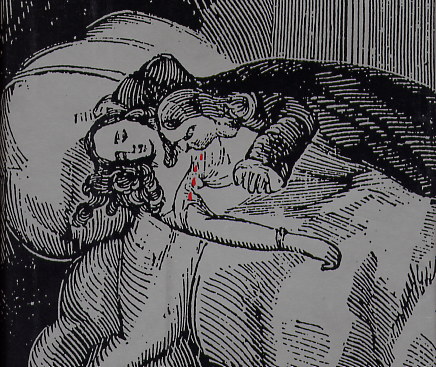

My argument is Wharton and Aickman's tales are unusual attempts to combine the vampiric with écriture féminine, and you can see this best when you read "Mr Jones" in the light of "Pages from a Young Girl's Journal." Both owe much to Ann Radcliffe especially in her earliest phase of The Romance of the Forest.
MR JONES
Brief Biography:
Edith Wharton. Her years 1862-1937. Fine writer of novels, travel books, criticism, ghost stories. She spoke of them very well. Numbers of her novels have been made into films, Ethan Frome; Age of Innocence; Buccanneers. Born to a distinguished (old wealth) and wealthy New York family; went to expensive private schools; spent last years in France. Many of her novels are novels of manners in the English way; she travelled on the continent and wrote books on Italy, Italian gardens, the Decoration of traditional houses. She married in 1885, at the age 23; no knowledge of the world nor sex; incompatible with husband who eventually went mad; she suffered depressions. She did have a close male friend who was a support to her all her life emotionally and as a writer: Walter Berry, intelligent, well-read lawyer; he was skilled in several languages; rad science, history, biograhpy, travel, and archeology. They read together; he went over her manuscripts of all her books. One brief physical love affair with one Morton Fullerton which she never forgot. She was heavily involved in war-work in World War One (as a nurse); took charge of 600 refugee children. Wrote about the war.Basically, she lived a life of writing and travel which she shared with Berry. She also became very close with another writer, Henry James, who also wrote a number of ghost stories. She discussed her work with him too. She made good money from her work.
"Mr Jones" was first published in Certain People, 1930.
Things to notice.
PAGES FROM A YOUNG GIRL'S JOURNAL
Brief Biography and Critical Commentary:
Robert Aickman. His years are 1914-1981. Son of an architect who he said 'was the strangest man I've ever known'; his grandfather was a Victorian writer of ghost stories, Richard Marsh. Starting in mid-1960s he produced 11 short-story collections, two novels, an autobiogrpahy and two book on England's waterways. An interesting fact about him is that he is widely credited with saving the British canal system for coming generations. He was trained as an engineer, founded Inland Waterways Association of England. Two further modern writers who were interested in canals and railways: R. T. C. Bolt whose ghost story takes place around a canal; and Christopher Woodforde.Aickman is often compared to M. R. James because he works through suggestion, strangeness and the idea is supernatural danger lurks on the edge of consciousness, so too despondency and madness. All his stories seem expressionistic; that is, they are a single kind of symbol; some individual is trapped within a group of forces over whom he has no control. He said 'the good ghost story gives form and symbol to themes from the enormous areas of our own minds which we cannot directly discern, but which totally govern us'. Poetic projection of something inside our own consciousness. Things are seemingly normal, but vaguely threatening and implicitly violent. That is very like M. R. James. Except again and again the protagonist is received into nature through death. There is a similar kind of piece in the early part of our volume, by Vernon Lee, a woman, takes place in Venice. Aickman liked to write stories set in Venice. City upon the waters. This story seems to have first been published in a collection called Cold Hand in Mine (1975).
Things to notice:
These are two rare attempts to write vampire fiction through the mode of female gothic romance and écriture féminine.